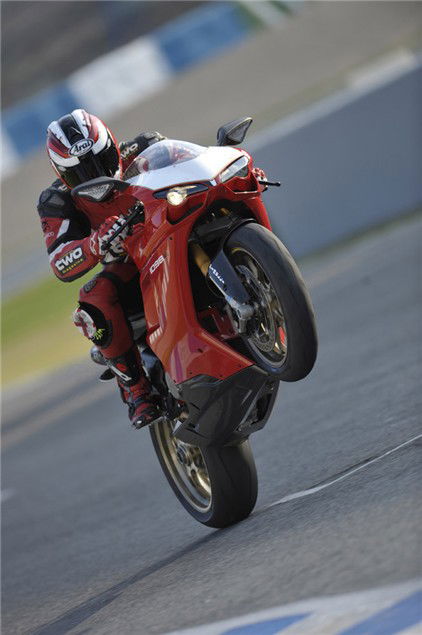First ride: Ducati 1098R
Thinking of buying a 1098R Ducati? Check out our first ride report of the ultimate factory superbike for the road
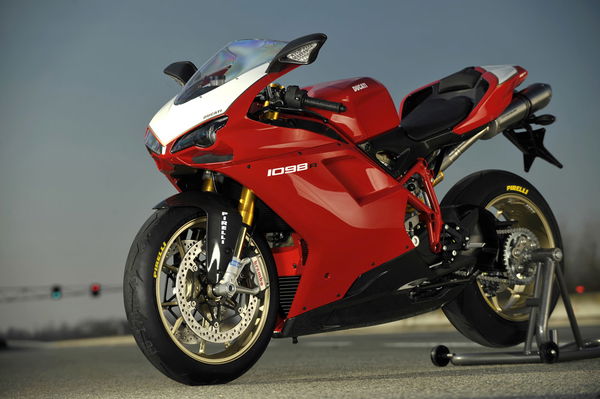
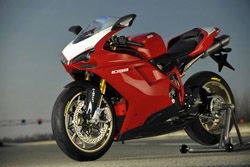 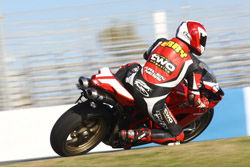 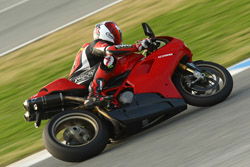 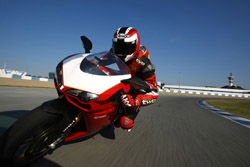 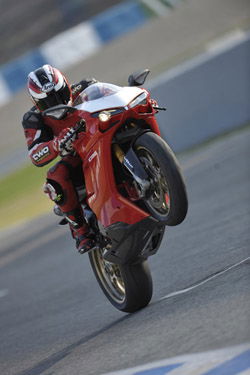 1098R Onboard Video
If you can’t beat them, get the rules changed so you can then build a bike with all the bits you need to dominate the racetrack out of the box. Ducati’s 1098R is pure WSB homologation magic... This time I’m going to be brave. Probably braver than I have been for a while. Ordinarily I wouldn’t put my trust in a small circuit board that in a few years time could well be found controlling my toaster, but the techno-boffin from Ducati has been consistently convincing and seeing as he had some flash diagrams on his PowerPoint presentation I reckon he knows his stuff. Well, that and the fact he claimed the technology wedged in a small box the size of a fag packet under my arse is the same as Casey Stoner uses on his MotoGP bike. The reason for my attempted burst of heroism is simple. I need to see if the traction control system on Ducati’s new 1098R really works. Unfortunately there is only one way to do this – whack the throttle open while still leant over. This action could have a number of consequences ranging from exiting the corner like a scalded cat, to exiting it 10-foot up in the air while adopting the traditional star shape with my arms and legs. To do something like this goes against all common sense, not to mention my accumulated knowledge of over 15 years of riding bikes. Mid-corner isn’t time to give it the ‘big one’, especially when this involves unleashing 180bhp on the rear tyre. But if they can put a man on the moon with less computing power than a TV remote control surely Ducati could invent a device that would keep both my wheels spinning at the same rate? So I grabbed a big handful, at which point it crossed my mind that Ducati hasn’t exactly got a reputation for electrical prowess. Admittedly, I’m being a bit light hearted about this whole traction control thing. Despite the fact it took some building up to the truth is I had no doubt that Ducati’s system would work perfectly. In both MotoGP and WSB the Italian firm has proved itself to be the masters of controlling spin, the motorcycling equivalent of Alastair Campbell if you will. So, as I expected (and hoped), the 1098R’s rear dug in, gripped and rocketed me out of the corner like a missile. So did the traction control worked? Well – sort of. For the launch of the 1098R Ducati chose to equip the bikes with Pirelli Diablo Supercorsa tyres, in very soft compound. So much so that the rear tyre was changed every three 15-minute sessions and the front every six. On a warm MotoGP quality circuit with tyres this sticky I’m not actually convinced that they would break traction, so I checked with Niall Mackenzie, and he agreed it was unlikely as well. But in a lot of ways that’s almost the point of it. Even if I knew for a fact that the grip was there, I’m not convinced I would have had the balls to just hold open the throttle of a Japanese inline four. But because I had this safety net on the equally powerful 1098R, it’s all about completely trusting the electronics, which is why the ‘old school’ MotoGP riders struggled in recent seasons. This admission might make me sound like I wasn’t testing the bike properly, but given the parameters that Ducati launched the 1098R I reckon that much of the talk about the traction control kicking in is what is known in the medical world as a ‘placebo effect.’ You want to feel it’s there, so you do. There again, when I adjusted the settings to the most sensitive setting, number eight, the traction control certainly did cut in, but at this point it was doing it when there was absolutely no chance of the tyre slipping. To completely convince me of the merits of the traction control I would have liked to test the bike on less sticky tyres and fiddled around a bit more with the system’s eight settings, but unfortunately we only got four session on track so I’d like to reserve judgement on the traction control system until now, especially as there is so much more to the 1098R than electronics. Without a shadow of doubt this new Ducati is as close to a real race bike as I have ever ridden. It’s an amazing machine. In the finest traditions of Ducati homologation specials the 1098R is little more than a way of Ducati ensuring its WSB bike is as competitive as humanly possible. But, as the rules have changed for 2008 to allow 1,200cc twins into the series this has created a bit of a monster. In order to appease the Japanese 1,000 brigade, and calm the storm created by upping the capacity limit of the already super competitive V-twins, the WSB rule makers have imposed some very tight restrictions on what Ducati can change between its race bike and road one. So what has Ducati done? Simple, given the road bike everything it needs to race in WSB and sod the cost. This bike has more trick components than most of the WSB grid as standard! Ducati call the 1098R a ‘pure and simple race bike,’ and it is. The new 1,198cc motor, up 100cc thanks to a bigger bore and stroke, has titanium con rods, titanium valves, a lightened crank, sand-cast cases, a slipper clutch, specially treated rocker arms to the same specification as the current WSB racer, the list goes on, see the tech panel for the full low-down. In stock, road legal, trim it churns out a claimed 180bhp and 99ft.lb of torque, which is amazing for a twin and not a million miles off the 200bhp area that the Airwaves BSB Ducati 999s had last year. Which isn’t surprising because all that Ducati is allowed to change for its WSB racer is the pistons, re-balance the crank and fit a new lighter fly-wheel and new gear ratios. In racing terms that’s not much, like I say, this truly is a race bike for the road. And it’s also a bloody missile. Around the Jerez track the 1098R’s engine was mind-blowing. Often the term ‘lazy’ is used to describe a Ducati V-twin’s power delivery, I would use the term ‘frenzied’ with the 1098R, or possibly ‘rabid.’ The lightweight internal components, as well as the bigger capacity, have turned this bike into a rev-happy monster with a midrange that is like someone has lit an afterburner. It’s stunning. Exiting any second gear corners at Jerez and as soon as I gave the 1098R some throttle it reared up like an angry horse. You simply can’t give it full throttle until it’s into third gear, such is the ferocity of the power delivery. It’s not uncontrollable, far from it, it’s just very powerful and with a claimed weight of 168kg the 1098R is also very light. Which is another reason why I believe that the traction control wasn’t playing a noticeable part, you can’t open the throttle mid-corner with any gusto until third gear because it will wheelie, which gives the rubber an easier time. If you can imagine riding an SV650 and then being given a TL1000 that is the difference between the 1098S and the 1098R’s motors, such is the magnitude of the engine work. But although the engine’s power deliver and fuel-injection system were stunning and very precise on more than a few occasions its enormous power and torque started to upset the chassis. Remember that the 1098R is little more than a race bike and was fitted with sticky rubber, but exiting a few of the corners under power was enough to start the Ducati shaking its head. It’s not unstable, but because the drive is so strong it lightens the front wheel enough to make it kick and protest if it comes back to ground slightly crossed up or hits a bump when the suspension is unloaded. A bit like the original model ZX-10R this gives for a thrilling ride on track and makes you feel like a GP star as you wrestle and fight the bike as it kicks and bucks for the first few yards as you power up the straight. It’s not long until it calms down again, but the 1098R is so fast even fairly long straights seem short and the corners don’t half rush up on you. Not that this is much of an issue with the Ducati. Not only are the Brembo monoblock brakes shockingly powerful, the front end of the 1098R feels pinned to the floor. I’ve never ridden a bike that gives you so much confidence in the front end grip. I’m not a big fan of braking into corners, I prefer to do it in a straight line, but the 1098R feels so good and turns so quickly I was holding onto the brakes well into the turn. The Ducati refused to become flustered and happily turned tighter or leant over further when I got it a bit wrong. And once on its ear the 1098R retains all the mid-corner poise and balance that has become a tradition with Ducati’s superbikes. The level of feedback, balance and compliance that the Öhlins suspension and a totally sorted chassis gives is unsurpassed on any other road bike I’ve ridden, it’s the kind of level that you would expect from a race bike, but that’s what an ‘R’ version Ducati is, especially this one. The term ‘race bike with lights’ has become so overused it’s meaning has been completely diluted. A CBR600RR isn’t a race bike with lights, it’s a million miles from the WSS racer, it just looks the same. But Ducati’s 1098R really is as close as it gets. Its performance is mind-bending, the handling stunning and the level of technology you get for your money is awesome. Yes, £24,000 is a hell of a lot of cash, but this is a race machine built to the level of Honda’s legendary RC30. Because the rules are so tight now regarding WSB, Ducati has been forced to unleash on the world a bike that is incredibly sophisticated and dripping with materials and technology that you just don’t get on any other bike. I can’t see how the 1098R isn’t going to decimate the opposition in Superstock racing and I reckon that the Japanese will be calling for tighter weight restriction in WSB after the first few rounds. Because the 1098R is such a dedicated machine you have to accept that it will have some issues that won’t make it a great road bike, but that’s not the point. Around a circuit the Ducati was sublime and probably the best track bike I have ever ridden for both handling and pure rider enjoyment. It’s exciting, thrilling and gets your adrenalin flowing in a way that few other bikes can while providing a soundtrack like nothing else through the two race Termignonis. The traction control certainly isn’t a gimmick, racers will exploit its full potential and for road riders and track day enthusiasts it’s a great safety net and confidence boost. How effective it is I’m yet to be convinced by, I’d like to test it on my own terms and in the wet. My meagre four sessions around Jerez opened my eyes to what it must be like to ride a proper race bike. It’s a world few of us can ever enter, but with the 1098R a lucky select can have a small taster. And now I need to go and have a quiet sit down... | |||||||||||||||
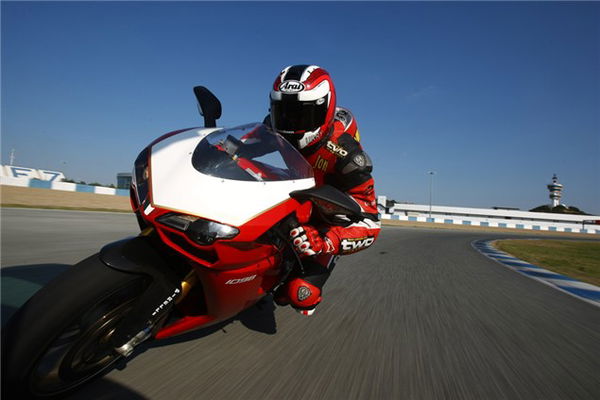
If you can’t beat them, get the rules changed so you can then build a bike with all the bits you need to dominate the racetrack out of the box. Ducati’s 1098R is pure WSB homologation magic...
This time I’m going to be brave. Probably braver than I have been for a while. Ordinarily I wouldn’t put my trust in a small circuit board that in a few years time could well be found controlling my toaster, but the techno-boffin from Ducati has been consistently convincing and seeing as he had some flash diagrams on his PowerPoint presentation I reckon he knows his stuff. Well, that and the fact he claimed the technology wedged in a small box the size of a fag packet under my arse is the same as Casey Stoner uses on his MotoGP bike.
The reason for my attempted burst of heroism is simple. I need to see if the traction control system on Ducati’s new 1098R really works. Unfortunately there is only one way to do this – whack the throttle open while still leant over. This action could have a number of consequences ranging from exiting the corner like a scalded cat, to exiting it 10-foot up in the air while adopting the traditional star shape with my arms and legs.
To do something like this goes against all common sense, not to mention my accumulated knowledge of over 15 years of riding bikes. Mid-corner isn’t time to give it the ‘big one’, especially when this involves unleashing 180bhp on the rear tyre. But if they can put a man on the moon with less computing power than a TV remote control surely Ducati could invent a device that would keep both my wheels spinning at the same rate? So I grabbed a big handful, at which point it crossed my mind that Ducati hasn’t exactly got a reputation for electrical prowess. Admittedly, I’m being a bit light hearted about this whole traction control thing. Despite the fact it took some building up to the truth is I had no doubt that Ducati’s system would work perfectly. In both MotoGP and WSB the Italian firm has proved itself to be the masters of controlling spin, the motorcycling equivalent of Alastair Campbell if you will. So, as I expected (and hoped), the 1098R’s rear dug in, gripped and rocketed me out of the corner like a missile. So did the traction control worked? Well – sort of.
For the launch of the 1098R Ducati chose to equip the bikes with Pirelli Diablo Supercorsa tyres, in very soft compound. So much so that the rear tyre was changed every three 15-minute sessions and the front every six. On a warm MotoGP quality circuit with tyres this sticky I’m not actually convinced that they would break traction, so I checked with Niall Mackenzie, and he agreed it was unlikely as well. But in a lot of ways that’s almost the point of it. Even if I knew for a fact that the grip was there, I’m not convinced I would have had the balls to just hold open the throttle of a Japanese inline four. But because I had this safety net on the equally powerful 1098R, it’s all about completely trusting the electronics, which is why the ‘old school’ MotoGP riders struggled in recent seasons. This admission might make me sound like I wasn’t testing the bike properly, but given the parameters that Ducati launched the 1098R I reckon that much of the talk about the traction control kicking in is what is known in the medical world as a ‘placebo effect.’ You want to feel it’s there, so you do. There again, when I adjusted the settings to the most sensitive setting, number eight, the traction control certainly did cut in, but at this point it was doing it when there was absolutely no chance of the tyre slipping.
To completely convince me of the merits of the traction control I would have liked to test the bike on less sticky tyres and fiddled around a bit more with the system’s eight settings, but unfortunately we only got four session on track so I’d like to reserve judgement on the traction control system until now, especially as there is so much more to the 1098R than electronics.
Without a shadow of doubt this new Ducati is as close to a real race bike as I have ever ridden. It’s an amazing machine. In the finest traditions of Ducati homologation specials the 1098R is little more than a way of Ducati ensuring its WSB bike is as competitive as humanly possible. But, as the rules have changed for 2008 to allow 1,200cc twins into the series this has created a bit of a monster. In order to appease the Japanese 1,000 brigade, and calm the storm created by upping the capacity limit of the already super competitive V-twins, the WSB rule makers have imposed some very tight restrictions on what Ducati can change between its race bike and road one. So what has Ducati done? Simple, given the road bike everything it needs to race in WSB and sod the cost. This bike has more trick components than most of the WSB grid as standard!
Ducati call the 1098R a ‘pure and simple race bike,’ and it is. The new 1,198cc motor, up 100cc thanks to a bigger bore and stroke, has titanium con rods, titanium valves, a lightened crank, sand-cast cases, a slipper clutch, specially treated rocker arms to the same specification as the current WSB racer, the list goes on, see the tech panel for the full low-down. In stock, road legal, trim it churns out a claimed 180bhp and 99ft.lb of torque, which is amazing for a twin and not a million miles off the 200bhp area that the Airwaves BSB Ducati 999s had last year. Which isn’t surprising because all that Ducati is allowed to change for its WSB racer is the pistons, re-balance the crank and fit a new lighter fly-wheel and new gear ratios. In racing terms that’s not much, like I say, this truly is a race bike for the road. And it’s also a bloody missile.
TRACTION CONTROL
What’s it all about then?
Ducati’s traction control system consists of two wheels speed sensors and an additional onboard computer, or ECU. The wheel speed sensors send information to the traction control’s ECU which then compares this data with the bike’s ECU, which records engine speed, throttle position, revs, etc, just like most other modern bikes. These ECUs make thousands of calculations a second and compare the data supplied by the sensors with pre-determined algorithms, basically comparison charts for the data. Once the traction control’s ECU decides that the data has fallen outside its allowed boundaries (the rear is spinning) it cuts the spark to reduce the engine’s power, allowing the tyre to grip. Ducati’s system has eight different levels of sensitivity and can be totally disabled if necessary. According to Ducati the algorithm in the 1098R’s ECU is exactly the same as used on the MotoGP and WSB race bikes. If you raced a 999R last year this bit of kit would have set you back around £250,000!
Around the Jerez track the 1098R’s engine was mind-blowing. Often the term ‘lazy’ is used to describe a Ducati V-twin’s power delivery, I would use the term ‘frenzied’ with the 1098R, or possibly ‘rabid.’ The lightweight internal components, as well as the bigger capacity, have turned this bike into a rev-happy monster with a midrange that is like someone has lit an afterburner. It’s stunning. Exiting any second gear corners at Jerez and as soon as I gave the 1098R some throttle it reared up like an angry horse. You simply can’t give it full throttle until it’s into third gear, such is the ferocity of the power delivery. It’s not uncontrollable, far from it, it’s just very powerful and with a claimed weight of 168kg the 1098R is also very light. Which is another reason why I believe that the traction control wasn’t playing a noticeable part, you can’t open the throttle mid-corner with any gusto until third gear because it will wheelie, which gives the rubber an easier time.
If you can imagine riding an SV650 and then being given a TL1000 that is the difference between the 1098S and the 1098R’s motors, such is the magnitude of the engine work. But although the engine’s power deliver and fuel-injection system were stunning and very precise on more than a few occasions its enormous power and torque started to upset the chassis.
Remember that the 1098R is little more than a race bike and was fitted with sticky rubber, but exiting a few of the corners under power was enough to start the Ducati shaking its head. It’s not unstable, but because the drive is so strong it lightens the front wheel enough to make it kick and protest if it comes back to ground slightly crossed up or hits a bump when the suspension is unloaded. A bit like the original model ZX-10R this gives for a thrilling ride on track and makes you feel like a GP star as you wrestle and fight the bike as it kicks and bucks for the first few yards as you power up the straight. It’s not long until it calms down again, but the 1098R is so fast even fairly long straights seem short and the corners don’t half rush up on you.
Not that this is much of an issue with the Ducati. Not only are the Brembo monoblock brakes shockingly powerful, the front end of the 1098R feels pinned to the floor. I’ve never ridden a bike that gives you so much confidence in the front end grip. I’m not a big fan of braking into corners, I prefer to do it in a straight line, but the 1098R feels so good and turns so quickly I was holding onto the brakes well into the turn. The Ducati refused to become flustered and happily turned tighter or leant over further when I got it a bit wrong. And once on its ear the 1098R retains all the mid-corner poise and balance that has become a tradition with Ducati’s superbikes. The level of feedback, balance and compliance that the Öhlins suspension and a totally sorted chassis gives is unsurpassed on any other road bike I’ve ridden, it’s the kind of level that you would expect from a race bike, but that’s what an ‘R’ version Ducati is, especially this one.
The term ‘race bike with lights’ has become so overused it’s meaning has been completely diluted. A CBR600RR isn’t a race bike with lights, it’s a million miles from the WSS racer, it just looks the same. But Ducati’s 1098R really is as close as it gets. Its performance is mind-bending, the handling stunning and the level of technology you get for your money is awesome. Yes, £24,000 is a hell of a lot of cash, but this is a race machine built to the level of Honda’s legendary RC30. Because the rules are so tight now regarding WSB, Ducati has been forced to unleash on the world a bike that is incredibly sophisticated and dripping with materials and technology that you just don’t get on any other bike. I can’t see how the 1098R isn’t going to decimate the opposition in Superstock racing and I reckon that the Japanese will be calling for tighter weight restriction in WSB after the first few rounds.
Because the 1098R is such a dedicated machine you have to accept that it will have some issues that won’t make it a great road bike, but that’s not the point. Around a circuit the Ducati was sublime and probably the best track bike I have ever ridden for both handling and pure rider enjoyment. It’s exciting, thrilling and gets your adrenalin flowing in a way that few other bikes can while providing a soundtrack like nothing else through the two race Termignonis. The traction control certainly isn’t a gimmick, racers will exploit its full potential and for road riders and track day enthusiasts it’s a great safety net and confidence boost. How effective it is I’m yet to be convinced by, I’d like to test it on my own terms and in the wet.
My meagre four sessions around Jerez opened my eyes to what it must be like to ride a proper race bike. It’s a world few of us can ever enter, but with the 1098R a lucky select can have a small taster. And now I need to go and have a quiet sit down...
TECHNICAL HIGHLIGHTS
Engine
The 1098R’s Testastretta Evoluzione engine is based around the 1098’s motor but has an increased 1198.4cc capacity with a 2mm bigger bore and stroke of 106x67.9mm. To match this new capacity the inlet and exhaust valves are 2mm larger diameter at 44.3mm and 36.2mm respectively. Overall the 1098R’s engine is 2.2kg lighter than the 1098S. The con rods are titanium as are the valves, the engine cases are sand cast for strength and a slipper clutch is fitted as standard. The throttle bodies are bigger at 63.9mm and the 1098R uses a dual injector per cylinder fuel injection system. The net result is a claimed 180bhp at 9,750rpm (likely to be 160bhp at the wheel) with 99.1ft.lb of torque at 7,750rpm. Carbon Termignoni race cans are included in the price.
Chassis
While the geometry stays the same the 1098R weighs 165kg, 6kg less than the 1098S. The sub-frame is aluminium (no pillions), wheels forged alloy and most of the fairing carbon fibre. Öhlins has supplied their very latest TTX36 shock for the 1098R (the first time on a road bike), which uses twin-tube technology to give more direct damping characteristics. The forks are Öhlins’ finest as is the steering damper. Like the ‘S’ the ‘R’ comes with Brembo monoblock calipers.
Electrics
The 1098R comes with Ducati’s data logging system, a race ECU to match the pipes and Ducati Traction Control (DTC) fitted.
Interview Andrea Forni, Ducati technical director
Why do Ducati say the 1098R’s traction control is for the race track and not the road?
It is possible to use it on the road but when you use the motorcycle on the road theoretically you should use the street legal silencers. These have catalytic converters in the muffler. Since our system works by reducing the spark there is a risk of some unburnt fuel getting to the catalytic converter, reducing its durability. So we recommend to only use with the open mufflers, they have no catalytic converters.
You say the traction control’s algorithm is the same as the MotoGP and WSB team, is there not a danger of rivals stealing this?
That’s true. Theoretically yes, but they would have to be capable of looking inside the chip and software. This is quite difficult, possible but difficult.
When developing the R’s engine was it hard to get it that close to the specification required for WSB while still retaining reliability that a road bike needs?
It was hard, of course. The problems were solved by the use of using expensive technology such as sand casting and titanium. The use of these components reduces your production capability as they take longer to make, but it is better to spend the money and have reliability than not and have problems. The race and road engines were developed together, but the parts we could change for the race engine we could make differently for the road bike, such as the pistons.
With the traction control could I just open the throttle wide mid-corner and be okay?
Well…err, our test rider tried this and said the traction control will cut the power. But personally speaking I do not recommend doing it. It is difficult to be 100% sure it will save you, it is not something that is born to improve safety, it is to allow very fast riders to ride close to the limit of the bike.
Can this system be developed for road only use?
With another set-up, absolutely yes, it is just about calibration. Do we plan to do that - the answer is why not? But it is not yet decided on which model. At the moment only on the 1098R and only for track use.
Ducati 1098R Specs
Price: £24,000
Engine: 1,198.4cc, liquid-cooled, DOHC, 8-valve V-twin
Power: 180bhp@ 9,750rpm
Torque: 99.1lb.ft@ 7,750rpm
Front suspension: Öhlins 43mm USD, fully adjustable, TiN coated
Rear suspension: Öhlins TTX36 monoshock, fully adjustable
Front brake: 330mm discs,
four-piston monoblock calipers
Rear brake: 245mm disc,
two-piston caliper
Dry weight: 165kg (claimed)
Seat height: 820mm
Fuel capacity: 17l
Top speed: 180mph (est)
Colours: Red


